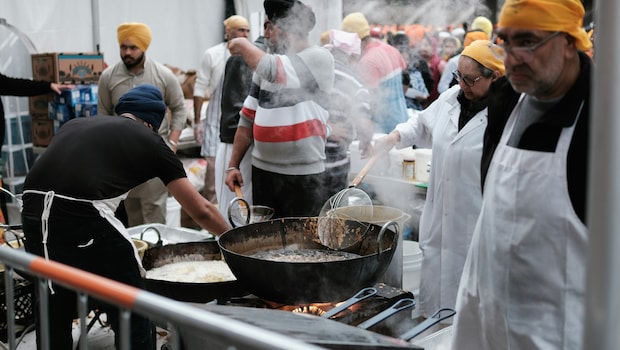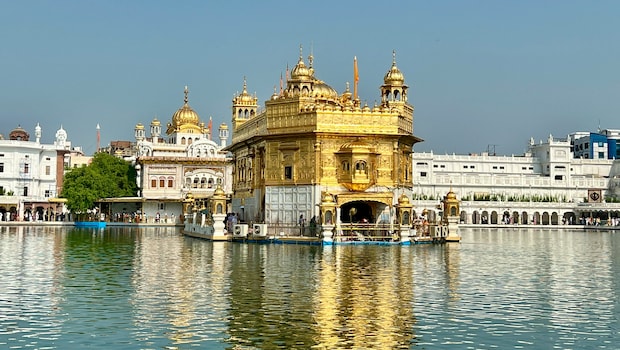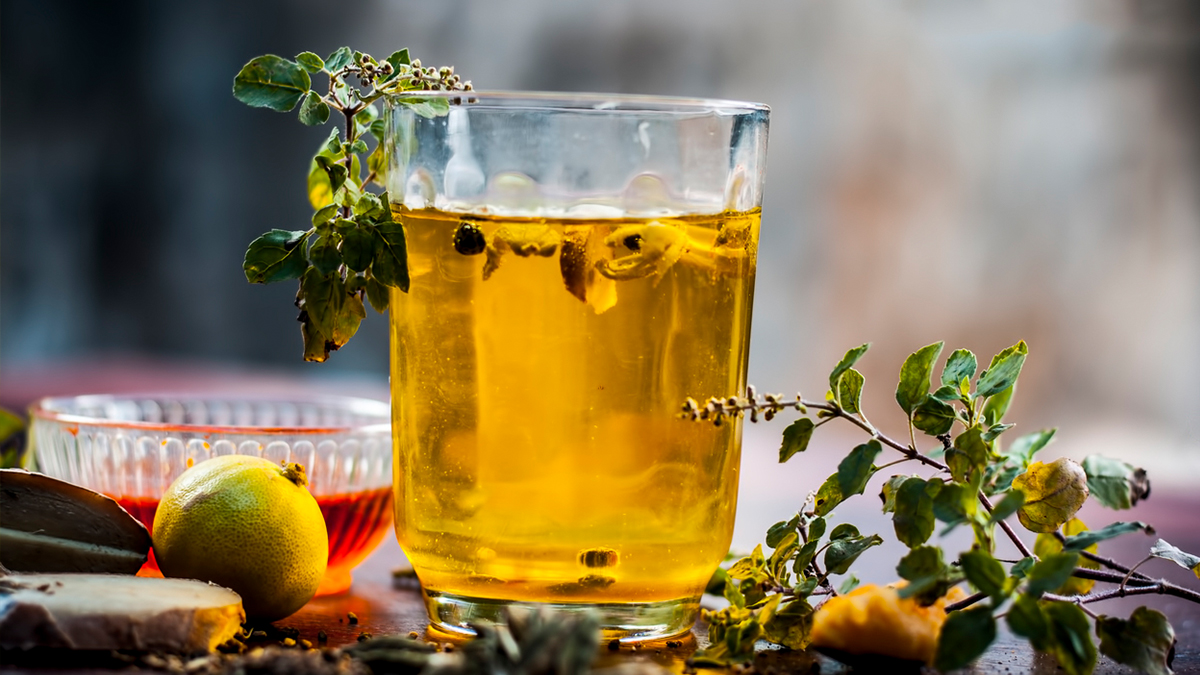In the heart of every Gurdwara, from the majestic Golden Temple in Amritsar to Gurdwara Bangla Sahib in Delhi, a quiet act of devotion unfolds daily - the langar. This community meal, served free to all regardless of caste, creed or background, is more than just food. It is a living embodiment of Sikh values: seva (selfless service), equality, humility and shared humanity. Prepared and served by volunteers, langar is a sacred ritual where the kitchen becomes a temple and the thali a symbol of unity.
The dishes may be simple - dal, sabzi, roti, kadha prasad. But they carry centuries of tradition and meaning. In a world often divided by privilege and hierarchy, langar offers a taste of oneness. This feature explores the dishes that define langar, the stories behind them, and the spirit of seva that binds it all together. Come, sit cross-legged, and savour the sacred simplicity of langar.
Also Read: Video Of Automatic Roti Making Machine At Delhi Gurudwara Is Going Viral
What Is Langar? A Tradition Rooted In Equality
Langar was first introduced by Guru Nanak in the 15th century as a radical response to social inequality. At a time when caste divisions dictated who could eat with whom, Guru Nanak envisioned a space where all sat together, shoulder to shoulder, and shared a meal. This act of communal dining was revolutionary - a spiritual and social equaliser.
Today, langar is served in Gurdwaras across the world. It is always vegetarian, always free, and always prepared with love. Whether you are a pilgrim, a tourist, or someone simply passing by, you are welcome to partake. No one is turned away. The food is served with humility, and the act of eating together reinforces the Sikh belief in universal brotherhood.
Core Principles Of Langar: Seva, Simplicity And Shared Humanity
1. Seva (Selfless Service)
Volunteers, known as sevadars, form the backbone of langar. They chop vegetables, knead dough, stir massive cauldrons of dal, and wash endless stacks of steel thalis. No task is too small, and every act is done with devotion.
2. Equality
Langar is served in pangat, which are rows where everyone sits on the floor, regardless of status. There are no reserved seats, no special treatment. The floor itself becomes a leveller.
3. Simplicity
The menu is modest, often comprising dal, sabzi, roti and rice. Yet, it is deeply nourishing. The simplicity reflects the Sikh ethos of humility and accessibility.

Photo Credit: UnSplash
The Langar Thali: Traditional Sikh Dishes That Nourish Body And Soul
A langar thali is not just a plate of food. It is a quiet sermon in simplicity, a sensory map of devotion, and a shared experience that transcends caste, class and creed. Each dish served in a gurdwara carries layers of meaning, rooted in tradition and offered with love.
1. Kadha Prasad: The Sacred Sweet That Begins Every Meal
The meal begins with Kadha Prasad, a warm, velvety halwa made from equal parts wheat flour, ghee and sugar. Offered first, often with folded hands, it sets the tone for the meal: sacred, generous and grounding.
- Rich in ghee and grainy in texture
- Symbolises divine grace and gratitude
- Always served fresh and warm
2. Dal: Hearty And Humble, The Heart Of Langar
Next comes the dal, usually made from urad or moong, slow-cooked in massive cauldrons with minimal spices. It is hearty, earthy and deeply nourishing.
- Cooked without elaborate tadka or garnish
- Offers warmth and sustenance
- Represents simplicity and nourishment
3. Sabzi: Seasonal Vegetables Cooked With Devotion
Alongside the dal is a seasonal sabzi, often aloo-gobhi, mixed vegetables or kaddu. Chopped by volunteers and cooked in large batches, it is served with a sense of abundance.
- Tastes like home-cooked food
- Reflects regional produce and traditions
- Evokes comfort and memory
4. Roti: Hand-Rolled Symbols Of Shared Effort
The roti is soft, hand-rolled and fresh off the tawa. Volunteers sit in rows, rolling dough and flipping rotis with rhythmic precision.
- Sometimes brushed with ghee, sometimes plain
- Always warm and generous
- Represents collective labour and love
5. Rice: A Gentle Accompaniment To Dal And Sabzi
Rice is often served when the sabzi is light or the dal is thin. Steamed and unadorned, it adds comfort and balance to the thali.
- Occasionally replaced with curd rice or lemon rice in southern gurdwaras
- Adds regional variety to the langar menu
- Completes the meal with subtlety
6. Chaas And Water: Refreshment In Steel Tumblers
To wash it all down, there is water or chaas, served in steel tumblers. The clink of tumblers, the coolness of the drink, and the shared silence of the pangat become part of the experience.
- Hydrating and simple
- Served with humility
- Reinforces the communal spirit
Why The Langar Thali Leaves A Lasting Impression?
Together, these dishes form a thali that is humble yet profound. There are no exotic ingredients, no fusion experiments, no chef signatures. And yet, the langar thali leaves a lasting impression, not just on the palate, but on the heart.
- Vegetarian and accessible to all
- Prepared and served by volunteers
- Embodies Sikh values of seva, equality and humility
Behind the Scenes: The Sacred Kitchen
Langar kitchens are marvels of coordination and devotion. At the Golden Temple, over 100,000 people are fed daily - and every chapati is rolled by hand. The scale is staggering, but the spirit remains intimate.
- Volunteers span generations: Children, elders, travellers - all are welcome to contribute.
- Utensils are shared: Steel thalis and tumblers are washed and reused, reinforcing sustainability.
- No one goes hungry: Meals continue until the last person is served.

Photo Credit: UnSplash
Regional Variations: Langar Across India
While the core menu remains consistent, regional influences do seep in.
- In Punjab, langar often includes sarson da saag in winter.
- In Delhi, you might find paneer sabzi on special occasions.
- In South India, some gurdwaras serve curd rice or lemon rice as part of langar.
- In Maharashtra, langar may include bhakri alongside roti.
These variations reflect the adaptability of langar , which is rooted in tradition, yet responsive to local tastes.
Langar Beyond The Gurdwara: Global Impact
Langar has travelled far beyond India. In London, Vancouver, Nairobi and Melbourne, Sikh communities serve langar at gurdwaras and even public events. During protests, natural disasters and humanitarian crises, langar kitchens have sprung up to feed thousands.
Conclusion: A Taste Of Oneness
Langar is basically a moment of surrender, of shared humanity, and of quiet revolution. In a world that often divides, langar reminds us that food can unite, not through extravagance, but through empathy.
So, the next time you sit cross-legged with a steel thali in hand, remember, you are part of something ancient, radical and beautiful.
About Somdatta SahaExplorer- this is what Somdatta likes to call herself. Be it in terms of food, people or places, all she craves for is to know the unknown. A simple aglio olio pasta or daal-chawal and a good movie can make her day.





